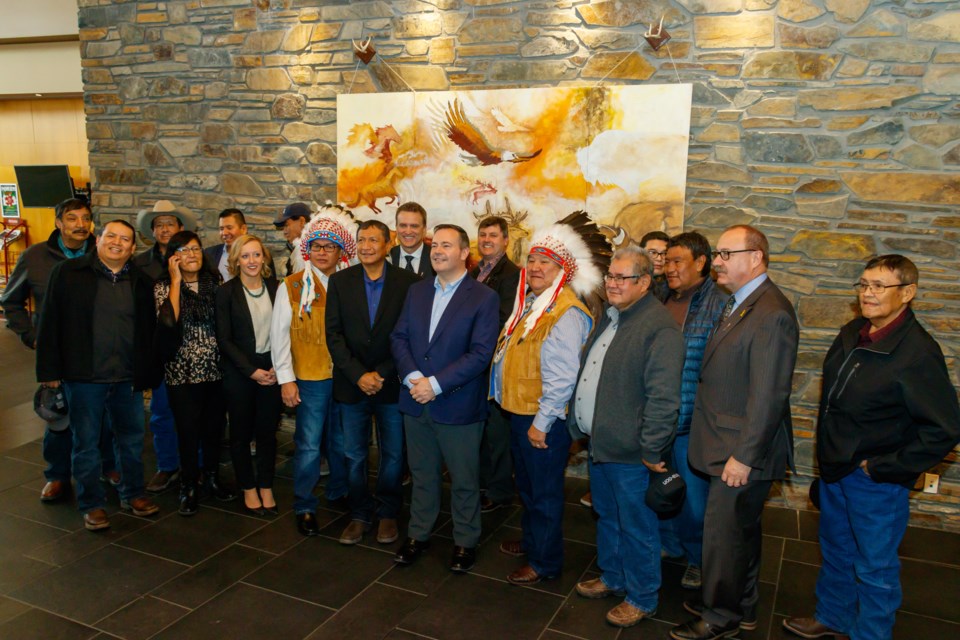STONEY NAKODA – Pledging a commitment to work with the Stoney Nakoda First Nation, Alberta Premier Jason Kenney announced $76.5 million has been earmarked in the Alberta Budget 2019 for the widening of Highway 1A to create a safer highway and promote Reconciliation.
The highway has been a safety concern for decades, said Kenney at a press conference at the Stoney Nakoda Resort and Casino on Tuesday (Nov. 12). He added widening of the highway has been a work-in-progress for too long. The highway was built in 1946 and has seen no significant upgrades since.
“We’ve finally successfully concluded an issue that has been discussed for over 30 years,” Kenney said. “I always say that Reconciliation cannot just be symbols and words it has to be actions. Today we are active.”
A 29-kilometre stretch of Highway 1A that runs between Canmore and Cochrane through the Stoney Nakoda First Nation will receive upgrades beginning in the spring of 2020. The project is expected to last two to three years.
The road will be doubled from 6.7 metres in width to 12 metres to allow shoulders on either side, the dips and hills the highway will be smoothed out and some of the curves will be straightened in an effort to reduce collision rates and make the highway safer, while making the road a more efficient and enjoyable trip for travellers.
“The number of accidents on this stretch of road is about twice as high as the average on roads in the rest of the province,” Kenney said. “This is a public safety imperative that we need to fix – there are members of the Stoney Nakoda community who to get from house-to-house, or from community-to-community, and they have to walk on a busy highway with no shoulders.”
Alberta Budget 2019 allocated $26.5 million towards this project in the four-year capital plan and pledged a further $50 million from future budgets.
The project was able to move forward after a land-transfer deal was agreed upon between the First Nation and the provincial government.
“The primary benefit of this work will be improved road safety. Both for people who drive it and those who walk or bicycle on its shoulders,” Kenney said. “Highway 1A is a vital connector between Calgary, Cochrane and Canmore and the Trans-Canada Highway.”
The highway averages approximately 2,000 vehicles each day and is also a primary access route to the Ghost Lake Recreation Area. The collision rates, including those involving animals, are significantly higher then they are for similar Alberta roadways.
“[Highway 1A] will be improved to a modern standard,” Kenney said.
Reconciliation has been a top priority for the provincial government, Kenney said, and the widening of Highway 1A is one of many ways they are working to support and partner with Indigenous communities to achieve shared goals.
He said he hopes the upgrades will create opportunities for the Stoney Nakoda that include new investments, jobs and other economic ventures.
Kenney met with the Stoney Nakoda chiefs and councillors in March of this year prior to the election, he said, and learned first-hand the efforts that were being made to update this critical infrastructure and the vital impact it would have in terms of the quality of life in the area.
“This is a concrete sign of partnership between the government of Alberta and the Stoney First Nation,” said the Premier.
The Stoney Nakoda First Nation, comprised of three bands, was represented at the press conference by three chiefs: Chiniki Chief Aaron Young, Wesley Chief Clifford Poucette and Bearspaw Chief Darcy Dixon.
Young described the announcement as an “awesome day,” and said he was grateful for the support the province has given to this project.
The partnership makes the nation and the province stronger, he said, making it an important day for the history books.
He noted that there is intent to include Indigenous workers in the construction of the project.
“This is long overdue,” Young said, adding that he appreciates that the provincial government took the time to understand the concerns of the Stoney Nakoda Nation.
“As we move forward to the beginning of a stronger relationship, it benefits our people, especially young First Nations people – it marks a relationship of Reconciliation.”



